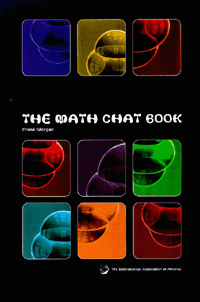- About MAA
- Membership
- MAA Publications
- Periodicals
- Blogs
- MAA Book Series
- MAA Press (an imprint of the AMS)
- MAA Notes
- MAA Reviews
- Mathematical Communication
- Information for Libraries
- Author Resources
- Advertise with MAA
- Meetings
- Competitions
- Programs
- Communities
- MAA Sections
- SIGMAA
- MAA Connect
- Students
- MAA Awards
- Awards Booklets
- Writing Awards
- Teaching Awards
- Service Awards
- Research Awards
- Lecture Awards
- Putnam Competition Individual and Team Winners
- D. E. Shaw Group AMC 8 Awards & Certificates
- Maryam Mirzakhani AMC 10 A Awards & Certificates
- Two Sigma AMC 10 B Awards & Certificates
- Jane Street AMC 12 A Awards & Certificates
- Akamai AMC 12 B Awards & Certificates
- High School Teachers
- News
You are here
Frank Morgan's Math Chat - Once in a Blue Moon
 |
 |
December 20, 2001
OLD CHALLENGE (Joe Shipman). This past Halloween was a "blue moon," the second full moon in a month. Assuming that the interval between full moons is exactly 19/235 of a year (about 29.5 days), blue moons occur 7 times in 19 years, but I read that there had not been one on Halloween for forty-odd years. What is the maximum number of years that can go by before a full moon occurs on Halloween?
ANSWER. 76 (or maybe 152?). There are 235 full moons in a repeating 19-year cycle, equidistributed about 37.3 hours apart throughout the tropical or "solar" year (vernal equinox to vernal equinox) of 365.25 days. Each year, calendar days slip back by 1/4 day, until leap year, when they move forward 3/4 day, in a repeating 4-year cycle. So everything repeats in a 19 x 4 = 76-year cycle, in which each day covers 1.75 x 24 = 42 > 37.3 hours and includes a full moon at least once.
This argument ignores the omission of leap years in certain century years (such as 1900, 2100). Shipman says, "Various numerical considerations suggest that some dates might go up to 100 years with no full moon, but I haven't verified this yet." He suggests that in any case another 76 years for a total of 152 should guarantee that every day (except February 29) has at least one full moon.
John Robertson and Arthur Guetter report how errors in Sky and Telescope magazine led to the current definition of a "Blue Moon" as the second full moon in a month. It originally meant the fourth full moon in a season, but even "season" can have a subtle meaning. See the article at http://www.skypub.com/sights/moonplanets/9905bluemoon.html
QUESTIONABLE MATHEMATICS. Eric Brahinsky reports that according to an article by Hector Saldana in the San Antonio Express-News (November 6, 2001), the following record is slated for inclusion in the Guinness World Records 2002:
A Wisconsin man ate 17,500 McDonald's Big Mac hamburgers in one day.
Readers are invited to submit more examples of questionable mathematics.
WINTER arrives tomorrow (December 21) at 2:12 pm Eastern time. The northern hemisphere will be tilted directly away from the sun, providing night everywhere inside the artic circle.
NEW CHALLENGE. In general, how would night and day differ if Jupiter's orbit held instead a second, little sun?
Copyright 2001, Frank Morgan.
Send answers, comments, and new questions by email to Frank.Morgan@williams.edu, to be eligible for Flatland and other book awards. Winning answers will appear in the next Math Chat. Math Chat appears on the first and third Thursdays of each month. Prof. Morgan's homepage is at www.williams.edu/Mathematics/fmorgan.
THE MATH CHAT BOOK, including a $1000 Math Chat Book QUEST, questions and answers, and a list of past challenge winners, is now available from the MAA (800-331-1622).




